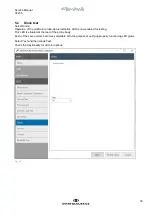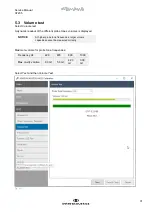
Service Manual
AT235
IV
The pressure accuracy is: ±10 daPa or 10%, whichever is greater.
To minimize the influence of temperature, barometer pressure, humidity and height
above sea level, it always recommended to calibrate the unit in the local positions.
Temperature
The temperature have no theoretic impact on the impedance calculation, but the
temperature has influence on the electronic circuits. This temperature influence for
the standard specified temperature range (15-35 °C) is inside:
Admittance can vary inside: ± 5%, ± 0.1 cm
3
, ±10
-9
m
3
/Pa·s, whichever is greater.
Reflex calibration standards and spectral properties:
General:
Specifications for stimulus and audiometer signals are made to follow IEC 60645-5
Contralateral earphone: Pure tone:
ISO 389-1 for TDH39 and ISO 389-2 for CIR.
Wide Band noise (WB):
Spectral properties:
Interacoustics Standard
As “Broad band noise” specified in IEC 60645-5, but with
500 Hz as lower cut-off frequency.
Low Pass noise (LP):
Spectral properties:
Interacoustics Standard
Uniform from 500 Hz to 1600 Hz, 5 dB re. 1000 Hz level
High Pass noise (HP):
Spectral properties:
Interacoustics Standard
Uniform from 1600 Hz to 10KHz, 5 dB re. 1000 Hz level
Ipsilateral Earphone:
Pure tone:
Interacoustics Standard
Wide Band noise (WB):
Spectral properties:
Interacoustics Standard
As “Broad band noise” specified in IEC 60645-5, but with
500 Hz as lower cut-off frequency.
Low Pass noise (LP):
Spectral properties:
Interacoustics Standard
Uniform from 500 Hz to 1600 Hz, 10 dB re. 1000 Hz level
High Pass noise (HP):
Spectral properties:
Interacoustics Standard
Uniform from 1600 Hz to 4000 Hz, 10 dB re. 1000 Hz
level
General about levels:
The actual sound pressure level at the eardrum will
depend on the volume of the ear.
The risk of artifacts at higher stimulus levels in reflex measurements are minor and will not activate the reflex
detection system














































